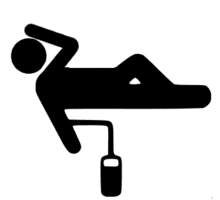Blood donation
- Bloodletting was the name for a medical practice which affected the health of the person.
Blood donation is when a person voluntarily gives blood, which can be used for blood transfusions or to make certain drugs. Blood banks store this blood. The blood can be used to help the victims of accidents, for example. Usually, the blood donor and the donated blood are tested for diseases which spread through the blood. These include various forms of Hepatitis, HIV, Haemophilia and Syphilis. Usually, a series of questions also need to be answered to make sure that there is no risk to the person donating.


A special case occurs before some medical operations. People donate their own blood, which can be used if they lose a lot of blood during surgery.
Conditions
changeThere are certain conditions on the people who can donate blood. Some of them vary by country, others are the same in most countries
Temporary exclusions
change- People who had a tattoo or piercing made need to wait for some time.
- People who had more than one sexual partner in the last few months need to wait for some time
- People who had certain vaccines in the last few months need to wait for some time.
- Women who are pregnant, or who are breastfeeding need to wait for some time
- People who have been to certain countries (and don't live there) need to wait for some time. Most of these countries are in the tropics.
Total exclusions
change- Drug addicts are excluded from donating blood
- Sex workers are excluded from donating blood
- People with certain diseases cannot donate blood (some of these are AIDS, Hepatitis, and Malaria).
- People who need to take certain drugs cannot donate blood
- In most countries, children cannot donate blood (without the consent of their parents)
In general, those donating blood need to be healthy.
Related pages
change